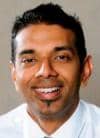by Greg Thompson
Tyler H. Jolley, DMD, is an orthodontist, periodontist, novelist, and mountain biker
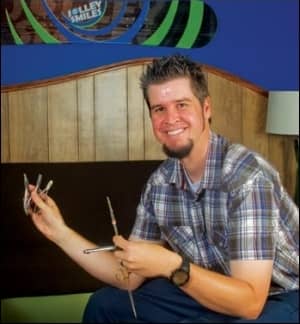
Tyler H. Jolley, DMD, is an orthodontist, periodontist, novelist, and mountain biker
If you know any orthodontic colleagues who also happen to be periodontists, you are in a distinct minority. Exact numbers are difficult to come by, but you could probably find just one dual specialist of this kind in every state. When Tyler H. Jolley, DMD, applied to the dual perio/ortho program at the University of Pennsylvania in the early 2000s, the venerable school was only accepting one student every other year.
Inspired by his professors at Nova Southeastern University School of Dental Medicine, Jolley nabbed the single coveted spot in the Penn program. He completed his 4-year orthodontic/periodontic residency in 2006, and is now able to bring a periodontist’s eye to the world of orthodontic treatment-planning. With three locations in Colorado (Grand Junction, Fruita, and Montrose) and one in Vernal, Utah, he also practices pure periodontics.
Today, the 35-year-old Utah-born clinician estimates that he is the only such dual specialist in Colorado and Utah. His specialized knowledge and skill give him a rare perspective on treating the entire mouth. He has published research articles in the Journal of Clinical Orthodontics, and he serves on the Quest Cleft Palate Team of Grand Junction. With no need to refer patients elsewhere, Jolley takes the reins for gingival grafting procedures for patients who need braces.
He also performs connective tissue grafting for patients (usually adults) who have or want braces. “These patients have had bone loss or gum disease,” Jolley explains. “They now want braces because they could never afford them when they were growing up. They have all this attachment breakdown, and you’ve got to get that under control to prepare for orthodontics or to help with existing braces.”

For patients with periodontal bacteria problems, Jolley says, “I do look at both sides of the perio/ortho coin, and I really try to help patients in both areas.”
PRACTICE PROFILE
Practice:Jolley Smiles
Name: Tyler H. Jolley, DMD
Education: Utah State University; Nova Southeastern (Fla); University of Pennsylvania
In Practice:4 years
Location: Grand Junction, Fruita, and Montrose, Colo; and Vernal, Utah
Starts per year: 370
Specialty: Orthodontics/Periodontics
Age: 35
Web site: jolleysmiles.com
Days worked per week: 5 to 6
Jolley’s periodontal talents have led him to treating a higher percentage of adults than most orthodontists. These older patients appreciate that the considerable experience needed to “straighten teeth” can only be augmented by Jolley’s ability to explore the underlying reasons why gums move and get broken down over the years.
Fellow orthodontists understand the rarity of Jolley’s dual specialty, but prospective patients need to be reminded. To this end, every advertising piece that emanates from Jolley Smiles prominently explains that both orthodontic and periodontic procedures are available under one roof.
“I still get people who are surprised by my dual role,” Jolley says. “Parents come in with their kid who has impacted canines, and I say, ‘You don’t need to go anywhere else because we can just do it here.’ Or if a child needs four premolars taken out for the orthodontic treatment, I can also get it done here in the office. They think that is pretty awesome.”
Cultivating general dental referral sources is an easy proposition for Jolley, because dental colleagues are happy to send patients to what frequently amounts to a one-stop shop. From a practical standpoint, Jolley’s four practices essentially amount to three operations: Grand Junction is an ortho/perio combination; Fruita is strictly ortho; Vernal (Utah) is exclusively perio; and Montrose is all orthodontics.
The Horrible Power
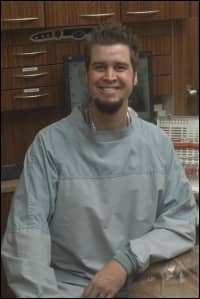
Jolley is quick to praise the amazing talents of his orthodontic colleagues, and he is often impressed by their considerable periodontal knowledge. The only minor complaint he offers is that too frequently orthodontists fail to respect the “horrible power” that periodontal bacteria can unleash. “I think a lot of orthodontists want to quickly move the teeth in hopes that patients will not be affected by the bacteria,” he laments. “It varies from clinician to clinician, but I do see a lot of cases where I immediately think, ‘Oh, man, they should not have braces on.’ Orthodontists don’t understand what kind of damage the ‘bugs’ can do, especially when you start moving teeth.”
Each case is different, but experience and education inevitably alter how each clinician views a particular case. As a relatively new practitioner with an unusual dual specialty, Jolley acknowledges that he is predisposed to “really worry” about gums. Tooth placement in the jaw is also a concern because Jolley wants his younger patients to avoid recession in later years.
“I worry about the transverse width because we see a lot of recession in the premolar and molar region,” Jolley explains. “When orthodontists just start throwing wires in the top and bottom, teeth are going to get flared out. When I diagnose a case for orthodontics or periodontics, I look at all aspects. If a perio patient has bone loss, I try to determine how he could benefit from orthodontics or even if he could benefit from orthodontics.”

There are a lot of things Jolley can do for perio patients with braces beyond simply straightening their teeth. Intruding or extruding teeth to level the interproximal bone is one method that he uses to get rid of bony defects. Also by uncrowding teeth, patients can achieve adequate plaque control.

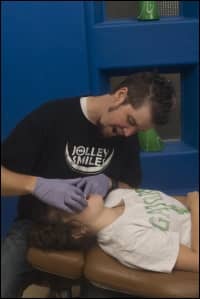
When he looks at an orthodontic case, Jolley is always looking for these types of fixes and asking himself how to best set up each patient for long-term periodontal health, gingival stability, tooth stability, and joint stability. “There are a lot of orthodontists that look at things like that, but there are a lot of orthodontists that just straighten teeth,” Jolley says. “Some orthodontists don’t really pay attention to the gums, and as a result patients come in when they are 30, and I’ve got a lot of business because I must graft the heck out of their gums, since teeth have moved too far out of their alveolar casing.”
Problems arise when orthodontists move teeth under “bacterial conditions” such as periodontal disease, and the result is a lot of lost bone. “The orthodontist finally says, ‘You better go see a periodontist,'” Jolley says. “I get to see them, and unfortunately these nice, straight, beautiful teeth now have to be removed, or they are ready to fall out because they are so loose. Why? Because orthodontists did not really pay attention to the periodontal bacteria. In those cases, I do look at both sides of the perio/ortho coin, and I really try to help patients in both areas.”
Taste for Technology
From his first exposure to TADs back in 2003 thanks to Robert Vanarsdall, DDS, Jolley has been enamored of the devices, which he avidly uses in his practice. Despite his affection for TADs, he believes that no solid evidence exists as to which brand is the best. “If I had a lot of money, I would start doing some research to find out which one is really the most effective,” Jolley says with a chuckle. “Fortunately, we have great universities that are looking into that.”
As a relative youngster in the dental field, Jolley admits to an affinity for technology such as Dolphin management software, and he often eschews the wait-and-see approach in favor of a get-there-first mentality. “I’m more than willing to try stuff, especially if they give it to me,” Jolley admits. “In the future, I would love to see a completely clear wire that actually works—not a metal wire that is Teflon-coated or painted. I also use Invisalign extensively, even for the teen market, and it has worked well.”
A Case to Test His Skills

When methamphetamine use severely damaged one patient’s teeth, Jolley collaborated with nearby prosthodontists and orthognathic surgeons to create an interdisciplinary plan. The woman eventually beat her addiction, but not before losing most of her upper and lower teeth, except for the front teeth.
She had damage from canine to canine in the maxilla and mandible, and the nature of the drug had caused the bacteria in her mouth to change. Myriad cavities sparked by neglect all added up to a difficult situation. “The teeth she had held onto were actually pretty good from the gum up, but now she had these really broken-down front teeth,” Jolley recalls. “The prosthodontist wanted to put implants in, and he would do some implant-supported bridges in the posterior segments. She had some really bad vertical dimension loss, bite collapse, and we needed to essentially straighten the broken-down teeth that remained to put crowns on and also prepare for implant placement.”
Jolley recently placed wires on the patient, primarily to make room for the prosthodontist to put crowns on. “She has temporary anchorage devices (TADs) going along with orthodontic appliances, and we are getting ready to do bilateral sinus lifts,” Jolley says. “After that, we are going to put some implants in. This may not be the most complex, but it is a really great combination case where we are using TADs, brackets and wires, and bone grafting for sinus lifts. With the help of an endodontist and prosthodontist, we want to restore function and obviously give her a really nice smile, because she has had a rough life.”
Greg Thompson is a contributing writer for Orthodontic Products. For more information, contact
Finding the “Happy Zone”
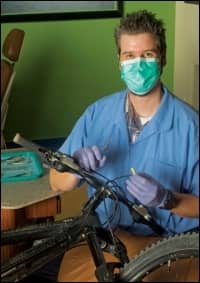
With dual dental specialties and hobbies that include snowboarding and writing novels, Jolley always seems to have his hands full.
There is no association for ortho/perio dual specialists, and if you decide to form one and nominate Tyler H. Jolley, DMD, as the president, chances are he’ll turn you down. A wife, three kids, four offices, and a passion for hiking and backpacking more than take up his time.
In the 1980s and 1990s, Jolley’s main mode of transportation was his old reliable skateboard. The 35-year-old orthodontist/periodontist doesn’t skateboard much anymore, but when he does it’s safe to say that he is the only skateboarding and snowboarding ortho/perio dual specialist on earth.
Rolling along in a big black truck or on a mountain bike is more common these days, and when it comes to the slopes, the snowboard wins out over skis every time. “I’m not really an adrenaline junkie, because I think those types of people live recklessly,” Jolley says. “I do like the somewhat risky brand of mountain biking because it is invigorating, as is snowboarding.”
Growing up on a farm fostered a love of the outdoors that motivates Jolley to leave behind the high-tech world of the dental professional as often as he can. “I love to backpack, and that is one of my biggest things that I do with my boys, who are ages 9, 7, and 4,” Jolley enthuses. “We just wander out in the wilderness, set up a tent, and live off the land for a couple of days.”
Jolley’s father is still a practicing dentist, but the elder Jolley chose to spend his money on tractors instead of sports cars. That decision led to a love of hard work that is now reflected in Tyler Jolley’s 5- to 6-day work weeks that often find him on highways headed for periodontal surgery appointments.
A penchant for daydreaming means those lengthy car trips can turn into creative sessions that end up in the adolescent novels that Jolley writes. As a fan of the “fun fiction” of Dan Brown and Michael Crichton, Jolley has completed his own science fiction novel and is searching for a publisher.
“Writing those books are how I deal with stress,” Jolley admits. “I just go to another place. With that said, I hated English in high school and almost failed it every time I took it in college. But with all my weird ideas, I need the creative outlet. My wife was an English major, and she is my editor.”
The themes Jolley prefers are complex, but he chooses to present them in an honest and uncomplicated way that is often more suited to the child reader. “It seems like adult authors are making it too smart,” Jolley explains. “They have done so much awesome research that it all feels like ‘fictional facts.’ If you read juvenile or teen-type literature, it is simple and honest. It flows well, and you are in that happy zone.”



